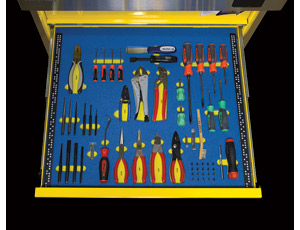Big Brother is watching your tools. That’s the idea behind a new asset-management system from Snap-on Industrial.


Born in the aerospace field, the company’s latest tool box is designed to help people in construction, especially those who work in high-risk areas that require tight security over “foreign-object damage” or “foreign-material exclusion”—such as nuclear powerplants—or those using large volumes of tools that are easily misplaced or stolen. The box relies on digital imaging technology.
How It Works
The Level 5 ATC (Automated Tool Control) system uses high-speed cameras, a mirror, a computer and foam cutouts to track tools. The idea is to have several layers of protection so that tools don’t end up left behind on a jobsite, where they could cause damage or get stolen. Snap-on invited ENR to review the unit on Jan. 26 at a sales meeting in Dallas.
The tool box, which plugs into a 110- or 220-volt outlet, unlocks when users wave a keycard over a switchplate on top of the box. Users then open a drawer and remove tools, such as a pair of pliers, from one of hundreds of foam pockets installed at the factory. The box can hold large and small tools alike, including sockets and screwdriver bits.
As the drawer closes, four to six 5-megapixel cameras, mounted at the top rear of the tool box, take pictures of the drawer as it slides shut. At 42 frames per second, the cameras shoot through a hidden mirror that hangs over the front edge of the box and then stitch together the images to record a digital representation of the drawer after each use. A computer then compares that image to a correct image programmed at the factory.
Because the cameras have curved lenses, stitching together a flat picture of the drawer posed a technical challenge. Snap-on solved this by placing little white dots on the sides of each drawer to help the cameras line up their shots. The cameras also are shooting from varying distances, depending on which drawer they are focused, so tool-box engineers designed in color and spatial tolerances—which users can tweak if needed—to cut down on false positives as cameras record items misplaced or missing.
After retrieving tools, users key in their work location and log out, and the box locks. Then, the box can send alerts and reports to the asset manager. If a user replaces the wrong item or lays down a foreign object, Big Brother is onto it.
Not long ago, tool companies were exploring technologies like radio-frequency identification (RFID) chips to track tools. The problem, they found, was that many items in tool boxes are smaller than the chips; also, the chips themselves can become foreign-object hazards.
Snap-on argued for fewer sensors, chips and wires in the war against lost and stolen tools. “Our position was, we don’t want to create a problem by solving another,” said Pat McDevitt, business development manager. The downside to this philosophy is that users can’t triangulate a tool’s location once it leaves its cozy foam pocket, as is possible with technologies such as RFID.
Snap-on borrowed its imaging technology from equipment it sells to help auto mechanics perform wheel alignments. Like the company’s other tool boxes, the basic shell is built in Algona, Iowa, where it is equipped with foam cutouts and tools that the buyer specifies. It is then shipped to Conway, Ark., the headquarters of Snap-on’s automotive division, where factory workers bolt on the imaging device and “teach” the toolbox how to recognize the tools.
ATC is available in a 36-in.-wide box for a retail price of $21,000 and a 54-in.-wide box for $26,000, not including tools. That’s about 50% more than a comparable box without the imaging system. Future models will include mobile units, even ones that can be taken outdoors.


Post a comment to this article
Report Abusive Comment